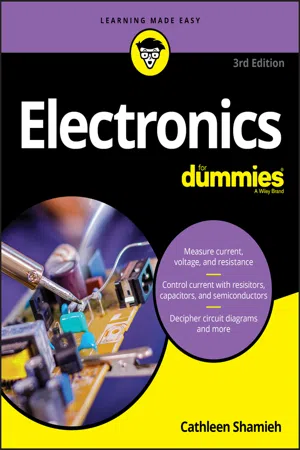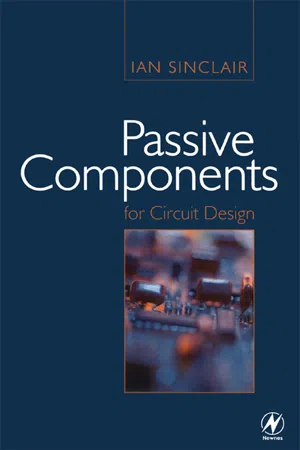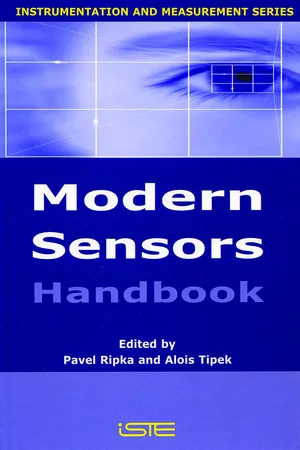Physics
Potentiometers
Potentiometers are variable resistors used to control electrical potential or voltage in a circuit. They consist of a resistive element and a sliding contact, allowing for precise adjustment of the voltage. By changing the position of the sliding contact, the resistance and voltage output can be varied, making potentiometers useful for applications such as volume controls and dimmer switches.
Written by Perlego with AI-assistance
9 Key excerpts on "Potentiometers"
- eBook - ePub
- Cathleen Shamieh(Author)
- 2019(Publication Date)
- For Dummies(Publisher)
Most often, Potentiometers are marked with their maximum value — 10 kΩ, 50 kΩ, 100 kΩ, 1 MΩ, and so forth — and they don’t always include the little ohm symbol (Ω). For example, with a 50 k pot, you can dial up any resistance from 0 to 50,000 Ω.Potentiometers are available in various packages known as dial pots, slide pots, and trim pots:- Dial potscontain rotary resistance tracks and are controlled by turning a shaft or knob. Commonly used in electronics projects, dial pots are designed to be mounted through a hole cut in a case that houses a circuit, with the knob accessible from outside the case. Dial pots are popular for adjusting volume in sound circuits.
- Slide potscontain a linear resistance track and are controlled by moving a slide along the track. You see them on stereo equipment (for instance, faders) and some dimmer switches.
- Trim pots(also known as preset pots ) are smaller, are designed to be mounted on a circuit board, and provide a screw for adjusting resistance. They are typically used to fine-tune a circuit — for instance, to set the sensitivity of a light-sensitive circuit — rather than to allow for variations (such as volume adjustments) during the operation of a circuit.
If you use a potentiometer in a circuit, bear in mind that if the wiper is dialed down all the way, you have zero resistance, and you aren't limiting current with this device. It's common practice to insert a fixed resistor in series with a potentiometer as a safety net to limit current. You just choose a value for the fixed resistor so it works with your variable resistor to produce the range of resistance you need. (Look for details about figuring out the total resistance of multiple resistors in series in the “Combining Resistors ” section, later in this chapter.)RECOGNIZING RHEOSTATS
The word potentiometer is often used to categorize all variable resistors, but another type of variable resistor, known as a rheostat , is different from a true potentiometer. Rheostats are two-terminal devices, with one lead connected to the wiper and the other lead connected to one end of the resistance track. Although a potentiometer is a three-terminal device — its leads connect to the wiper and to both - eBook - ePub
- Ian Sinclair(Author)
- 2000(Publication Date)
- Newnes(Publisher)
Chapter 3 Variable resistors, Potentiometers and diodes When a resistor, which can be constructed by any of the processes that have been dealt with in Chapter 2, is provided with a third contact that rubs on the resistive material and makes contact with it, then the amount of resistance between this third contact and either of the fixed contacts can be made variable since it will change when the position of the contact on the resistive surface is altered. This type of arrangement can be described as a rheostat, variable resistor, trimmer or potentiometer according to its prospective use. The common factor is that the position of the third contact is set mechanically, so distinguishing this type of resistance variation from the type that is found in photoconductive cells, where the resistivity of the material is changed by light, or in thermistors in which the resistivity of the material is changed by an alteration of temperature. Devices in which the resistivity of the material itself is changed are dealt with in Chapter 7. The three names that are used reflect the developments in the use of these components. The first radio receivers that used thermionic valves with tungsten filaments (bright-emitter valves) needed some method of controlling the filament temperature, and this was done by including a variable resistor in the circuit. Such a variable resistor or rheostat (the name means constant current) consisted of a wire winding on a ceramic tube, with one fixed contact and one moving contact (Figure 3.1), so that a variable length of resistance wire could be put in series in the circuit. This controlled the current by controlling the total resistance of the circuit - eBook - ePub
Sensor Systems
Fundamentals and Applications
- Clarence W. de Silva(Author)
- 2016(Publication Date)
- CRC Press(Publisher)
Note: Many other principles may be employed in Potentiometers for displacement sensing. For example, an alternative possibility for optical potentiometer is to have a fixed light source and to locate a photosensor on the moving object whose displacement needs to be measured. By calibrating the device according to how the light intensity varies with the distance between the light source and the light sensor, the distance can be measured. Of course, such a device would be quite nonlinear and nonrobust (as it will be affected by environmental lighting, etc.).8.3.3.1 Digital Potentiometer
The digital potentiometer is a device that can provide digitally incremented resistance or voltage corresponding to a digital command. The range of discrete resistance that it can provide depends on the bit size of the device (e.g., 8-bit device is able to provide 256 discrete values of resistance). The incrementing can be programmed linearly, logarithmically, etc., using a microcontroller or other digital device, depending on the application. It is clear that a digital pot is not a displacement sensor but rather a resistance splitter or voltage splitter. It is mentioned here to avoid any misconception.The potentiometer has disadvantages such as loading problems (both mechanical and electrical), limited speed of operation, considerable time constants, wear, noise, and thermal effects. Many of these problems arise from the fact that it is a contact device where its slider has to be in intimate contact with the resistance element of the pot and also has to be an integral part of the moving object whose displacements need to be measured. Next, we consider several noncontact motion sensors that do not have these shortcomings.8.4 Variable-Inductance Transducers
Motion transducers that employ the principle of electromagnetic induction are termed variable-inductance transducers. When the flux linkage (defined as magnetic flux density times the number of turns in the conductor) through an electrical conductor changes, a voltage in proportion to the rate of change of flux is induced in the conductor. This is the basis of electromagnetic induction - eBook - ePub
Basic Electronics [OP]
Theory and Practice
- Sean Westcott, Jean Riescher Westcott(Authors)
- 2020(Publication Date)
- Mercury Learning and Information(Publisher)
Some resistors do not carry a fixed resistance value and are called variable resistors. Types of variable resistors include thermistors (variable due to temperature) and photoresistors (variable due to levels of light), also known as photocells. Another variable resistor is the varistor (variable + resistor), which serves mainly to protect sensitive components from short spikes of excessive current. When triggered, it shunts the current away from the more current-sensitive components.FIGURE 7.3 The SIL resistor pictured here has nine resistors, each delivering 47Ω. The code reads 470, which equals 47 × 100 , or 47.FIGURE 7.4 Symbols for various types of resistors in a circuit diagram.One of the most commonly used variable resistors is the potentiometer (often simply referred to as a pot), which is familiar to anyone who has used a volume knob on an analog stereo or television. Instead of the simple two terminals (or leads) of fixed-value resistors, a potentiometer, or “pot,” has three terminals. The third terminal in a variable resistor can be moved to different tapping points to yield varying levels of resistance. The terminal that moves is usually in the center of the three-terminal arrangement and is called the wiper.A pot is usually controlled by a knob that moves the wiper to the different tapping points. Older televisions used tone knobs for the control of brightness, and car and home radios were once controlled by pots. Any analog signal can be controlled with a pot.Resistors have different symbols depending on whether they are fixed-value or variable resistors. Here are the symbols you would find in a circuit diagram for several of the most common types:Kirchhoff’s LawsTo calculate the proper resistance to use in a particular part of a circuit, it is necessary to look at the energy in that circuit. You already know that voltage pushes electrons, creating an electrical current. To understand what happens when you introduce resistance to that current, let’s look at another foundational concept of electronics: Kirchhoff’s laws. - eBook - ePub
- Pavel Ripka, Alois Tipek, Pavel Ripka, Alois Tipek(Authors)
- 2013(Publication Date)
- Wiley-ISTE(Publisher)
2 ) is measured offers more advantages.When operating in the rheostat mode the resistance R2 between the wiper at position x and one terminal of the resistive winding, x can be calculated from the simple equation:where R = R 1 + R 2 is the total resistance of the resistance winding (or resistive track) with length of x0 .The principle of operation in potentiometric mode is shown in Figure 7.1 . In potentiometric mode the output voltage U2 is given by the relation:and it is proportional to the resistance R2 which in turn is proportional to the position of the wiper x .Proportionality is valid only if the loading resistance RZ is much greater than R as it can be seen from the equivalent circuit (see Figure 7.1 ).Figure 7.1. Principle of operation of linear potentiometer with moving wiper and equivalent circuit diagram7.2.2. Angular position measurement
The rotational potentiometer is a common sensor for angular position measurement. Similarly as for the linear potentiometer, the output voltage U α measured on the slider (Figure 7.2 ) is proportional to its position.The range of angular Potentiometers is approximately 10° to 3,000° for the multi-turn Potentiometers (helipots).Figure 7.2. The principle of rotational potentiometer7.2.3. Draw wire sensors
In the draw wire sensors the transformation of translational movement to angular is performed by rolling up a cable made from metal or nylon on a spring-driven metal drum. The other end of the cable is fixed on the moving object, while the sensor case remains at a fixed position. The angular deflection is then measured by an angular potentiometer. - eBook - ePub
- Paul P.L. Regtien, Edwin Dertien(Authors)
- 2018(Publication Date)
- Elsevier(Publisher)
Two nonelastic wires are positioned along the leg, in parallel to the plane of rotation. At one end the wires are connected to each other and both other ends are connected to the sliders of two Potentiometers. Springs keep the wires stretched. On bending the free ends show a relative displacement related to the angle of rotation. The Potentiometers form a Wheatstone bridge, so only the position difference of the wire ends is measured. The resolution of the measurement is better than 0.1° over a range of 100°. The use of Potentiometers is not restricted to the measurement of linear and angular displacement. They can also be used for the measurement of acceleration, force, pressure, and level. In these cases the measurand is transferred to a displacement by a proper mechanical construction. Combined with a spring a potentiometer can act as a force sensor ; with a seismic mass fixed to the slider the construction is sensitive to acceleration. Potentiometric accelerometers are available for ranges up to 10 g, inaccuracy around 2% full scale (FS), and a lateral sensitivity less than 1% (i.e., 1% of the sensitivity along the main axis). Potentiometers find also application in gyroscopes with spinning rotor. When rotated, the axis of the rotor tends to maintain its original position hence making an angle with the sensor housing in proportion to the angular velocity. Gyroscopes are available in which two angles, roll and pitch, are measured by built-in Potentiometers. Another application is the measurement of level. For this purpose, Potentiometers of the type shown in Fig. 4.1C are used. In case of a liquid the one end of the flexible cable is connected to a float and at the other end wound on a drum. When the level is raising or lowering, the drum winds or unwinds; a rotational potentiometer measures the rotation of the drum - eBook - ePub
Real-Time Environmental Monitoring
Sensors and Systems - Textbook
- Miguel F. Acevedo(Author)
- 2023(Publication Date)
- CRC Press(Publisher)
1 is given by Equation (3.11) at any cursor position.Kirchhoff’s current law states that the sum of currents in and out of a circuit node adds to zero, as shown in Figure 3.9 for two resistorsI −. This is equivalent to say that the sum of all currents leaving a node must equal the sum of all currents entering a nodeI 1−I 2= 0I =.I 1+I 2FIGURE 3.9 Kirchhoff’s current law.The inverse of the equivalent resistance of resistances connected in parallel is calculated as the sum of inverses of all resistances. For example, two resistances R1 and R2 connected in parallel (Figure 3.10 ) yield an equivalent resistance R given byFIGURE 3.10 Resistances in parallel.Or equivalently(3.12)1 R=1+R 11R 2R =(3.13)R 1R 2R 1+R 2Recall that conductance G is the inverse of resistanceG = 1 / Rand therefore a more practical interpretation of Equation (3.13) is that the equivalent conductance of a parallel combination G is the sum of individual conductance values G1 and G2 .We form a current divider using two resistances in parallel. The current through one resistance is proportional to the input voltage multiplied by the fraction of the other resistance to the total equivalent resistance. For example, the voltage I1 through resistance R1 in Figure 3.11 isFIGURE 3.11 Current divider.(3.14)I 1= I ×R 2R 1+R 2For many purposes, we interpret a circuit as performing a function or producing an output for a given input. We typically conceptualize this as the relationship between an input voltage and an output voltage. A linear circuit produces an output voltage proportional to the input voltage over a range (Figure 3.12 left). A linear amplifier is an example of this type of relationship. However, we also have non-linear circuits for which the output voltage does not have the same proportion over a range. A simple example is a voltage comparator, which produces a completely different value once the input goes over a threshold (Figure 3.12 - eBook - ePub
Electronics
A First Course
- Owen Bishop(Author)
- 2010(Publication Date)
- Routledge(Publisher)
wiper . This is a springy metal strip that presses firmly against the track and makes electrical contact with it. It is attached to a sliding knob, used to move the wiper along the track. As it moves, the distance between one end of the track (say, A) and the wiper is changed. This changes the electrical resistance between A and the wiper. The resistance can have any value between zero and the resistance of the whole track.Slider pots are often used on audio equipment for setting the frequency response.A common form of variable pot is the rotary pot . This has a curved track, along which the wiper moves as the shaft is turned (Figure 14.2 )Figure 14.2 Often the track covers an angle of about 270°.Rotary pots are often used as volume controls in audio equipment and also for controlling the brightness of lamps, the speed of motors and many other purposes. The shaft can be fitted with a knob, if preferred.Sometimes we want to adjust a resistance when we are setting up a circuit. After ‘pre-setting’ or ‘trimming’ the circuit, we may not need to change the resistance again.We use a smaller rotary pot, known as a preset pot , or as a trimmer , or trimpot , which is adjusted with a screwdriver (Figure 14.3 ).Figure 14.3Special symbols are used for pots (left) and presets (right) (Figure 14.4 ). Zigzag versions are also used.Figure 14.4Design Tip
Pots need careful use. If the wiper is near one end of the track, the resistance between the wiper and the near end is small. As a result, the current through that part of the track is too high and burns out the track. If possible, wire a small fixed resistor in series with the wiper or track to limit the current to a safe amount.POWER RATINGS
Many fixed resistors are intended to conduct electricity at a maximum power of a quarter of a watt (250 mW). This power must not be exceeded.Example 1
The current through a 250 mW resistor is 10 mA and the voltage across it is 5 V. The power is 0.01 × 5 = 0.05 W 5 50 mW. Because the resistor is rated at 250 mW, it can safely run at 50 mW. It becomes only slightly warm as a result of the current passing through it. - eBook - ePub
- Ferat Sahin, Pushkin Kachroo(Authors)
- 2017(Publication Date)
- CRC Press(Publisher)
1 Fundamentals of Electronics and Mechanics In this chapter we will explore the fundamentals of Electronics and Mechanics. The example applications related to electrical and mechanical components are also presented.1.1 Fundamentals of Electronics
In this section, we explore electrical components, semiconductor devices, Operational Amplifiers (OPAMPs) and their applications, and digital systems components. There are some very good books that cover analysis of electric circuits such as [10 ] and [2 ]. There are also some good books on hands on robotics such as [7 ].1.1.1 Electrical Components
Resistors, capacitors, and inductors are basic electrical components used in electronic circuits. Some of the electrical components and their symbols are given in Figure 1.1 .1.1.1.1 Resistors
Resistors are components which resist the flow of electronic current. The resistors are mainly used to reduce the voltage applied to other components and to limit the current flowing through other components. The higher the value of the resistance, the lower the current will be. Resistance of a resistor is measured in terms of Ohms (Ω) since the relationship between voltage (V , volts), current (I , Ampere), and resistance (R ) is explained by Ohm’s law given in 1.1.V = I R( 1.1 )The most common resistors are made using a carbon rod core with end caps and wire leads. We can categorize resistors into two basic types: fixed and variable resistors (or Potentiometers). A fixed resistor is the one which has a fixed resistance value. Variable resistors have variable resistance values. The value of the resistor is often changed by a user by turning a knob or a dial. There are some special resistors designed to change in resistance when heated. They are called Thermistors and are used in temperature measuring circuits. The same idea is also used to design pressure sensors where a membrane is designed to be a resistor. The membrane resistance changes when it is deformed by the pressure in a chamber.
Index pages curate the most relevant extracts from our library of academic textbooks. They’ve been created using an in-house natural language model (NLM), each adding context and meaning to key research topics.
Explore more topic indexes
Explore more topic indexes
1 of 6
Explore more topic indexes
1 of 4



![Basic Electronics [OP]](https://img.perlego.com/book-covers/3026680/9781683925279_300_450.webp)




